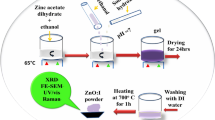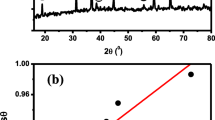Abstract
2,3,7,8,12,13,17,18-octaethyl-21H,23H-porphyrin Cobalt(II) (CoPor) was introduced into nanostructured organically modified silica (ORMOSIL) using a sol–gel technique. Scanning electron microscopy, Fourier transform infrared (FT-IR), thermogravimetric analysis, and UV–Vis spectroscopy were performed to investigate the morphology, structure, thermal stability, and linear optical properties of the resulting gel glasses. The FT-IR spectrum and UV–Vis spectra strongly indicated the formation of a silica gel glass network and the successful encapsulation of CoPor in ORMOSIL silica gel glasses, respectively. The introduction of guest CoPor molecules induces silica to form more condensed surface characteristics, owing to the fact that CoPor can promote the hydrolysis and polycondensation procedure, and hence have better thermal stability as compared to blank silica gel glasses. Meanwhile, the dimerization phenomenon in a liquid matrix can be effectively suppressed in a silica solid-state matrix and is attributed to the ‘cage protection effect.’ The nonlinear optical (NLO) properties of CoPor gel glasses were investigated using the open-aperture Z-scan technique at 532 nm. The NLO performance of CoPor-incorporated solid-state silica gel glasses has been improved in comparison with those dispersed in dimethylformamide solution. More significantly, the NLO properties of CoPor-doped ORMOSIL gel glasses can be controlled by adjusting the concentration of the CoPor molecules.










Similar content being viewed by others
References
L.W. Tutt, T.F. Boggess, A review of optical limiting mechanisms and devices using organic, fullerenes, semiconductors and other materials. Prog. Quant. Electron. 17, 299 (1993)
Y.P. Sun, J.E. Riggs, Organic and inorganic optical limiting materials. From fullerenes to nanoparticles. Int. Rev. Phys. Chem. 18, 43 (1999)
J. Wang, W.J. Blau, Inorganic and hybrid nanostructures for optical limiting. J. Opt. A: Pure Appl. Opt. 11, 024001 (2009)
L.W. Tutt, A. Kost, Optical limiting performance of C60 and C70 solution. Nature 356, 225 (1992)
R. Signorini, M. Meneghetti, R. Bozio, M. Maggini, G. Scorrano, M. Prato et al., Optical limiting and non linear optical properties of fullerene derivatives embedded in hybrid sol–gel glasses. Carbon 38, 1653 (2000)
J.W. Perry, K. Mansour, I.-Y.S. Lee, X.-L. Wu, P.V. Bedworth, C.-T. Chen et al., Organic optical limiter with a strong nonlinear absorptive response. Science 273, 1533 (1996)
H.L. Gu, S. Li, J. Wang, W.J. Blau, Y. Chen, Indium(III) and Gallium(III) phthalocyanines-based nanohybrid materials for optical limiting. Mater. Chem. Phys. 137, 188 (2012)
P.P. Kiran, D.R. Reddy, B.G. Maiya, D.N. Rao, Third-order nonlinearity and optical limiting studies in phosphorus(V) porphyrins with charge transfer states. Opt. Mater. 21, 565 (2003)
D.N. Rao, Excited state dynamics in porphyrins in relevance to third-order nonlinearity and optical limiting. Opt. Mater. 21, 45 (2003)
Y. Chen, Y. Lin, Y. Liu, J. Doyle, N. He, X.D. Zhuang et al., Carbon nanotube-based functional materials for optical limiting. J. Nanosci. Nanotech. 7, 1268 (2005)
J. Wang, Y. Chen, W.J. Blau, Carbon nanotubes and nanotube composites for nonlinear optical devices. J. Mater. Chem. 19, 7425 (2009)
J. Wang, Y. Hernandez, M. Lotya, J.N. Coleman, W.J. Blau, Broadband nonlinear optical response of graphene dispersions. Adv. Mater. 21, 2430 (2009)
Z.B. Liu, Y. Wang, X.L. Zhang, Y.F. Xu, Y.S. Chen, J.Q. Tian, Nonlinear optical properties of graphene oxide in nanosecond and picosecond regimes. Appl. Phys. Lett. 94, 021902 (2009)
R. Philip, P. Chantharasupawong, H. Qian, R. Jin, J. Thomas, Evolution of nonlinear optical properties: from gold atomic clusters to plasmonic nanocrystals. Nano Lett. 12, 4661 (2012)
C. Zheng, Y.H. Du, M. Feng, H.B. Zhan, Shape dependence of nonlinear optical behaviors of nanostructured silver and their silica gel glass composites. Appl. Phys. Lett. 93, 143108 (2008)
M. Calvete, G.Y. Yang, M. Hanack, Porphyrins and phthalocyanines as materials for optical limiting. Synth. Met. 141, 231 (2004)
M. Wang, R. Zuo, W. Meng, Y. Liu, Sol–gel derived CaO–B2O3–SiO2 glass/CaSiO3 ceramic composites: processing and electrical properties. J. Mater. Sci. 7, 843 (2011)
K.M. Kajihara, H.H. Hosono, Sol-gel synthesis of monolithic silica gels and glasses form phase-separating tetraethoxysilane-water binary system. Chem. Commun. 18, 2580 (2009)
H.B. Zhan, W.Z. Chen, H. Yu, M.Q. Wang, Encapsulation of aluminum tetrasulfophthalocyanine chloride in silica xerogel and its optical properties. Mater. Lett. 57, 1361 (2003)
H.B. Zhan, W.Z. Chen, J.C. Chen, M.Q. Wang, Dimerization of zinc tetrasulfophthalocyanine in sol–gel process. Mater. Sci. Eng. 100, 119 (2003)
H.B. Zhan, M.Q. Wang, W.Z. Chen, G.H. Li, Encapsulation of aromatic oxygen palladium phthalocyanine in silica xerogel and its optical limiting property. Opt. Mater. 22, 377 (2003)
M. Sheik-Bahae, A.A. Said, T.-H. Wei, D.J. Hagan, E.W.V. Stryland, Sensitive measurement of optical nonlinearities using single beam. IEEE J. Quant. Electron. 26, 760 (1990)
A. Fidalgo, R. Ciriminna, L.M. Iharco, M. Pagliaro, Role of the alkyl–alkoxide precursor on the structure and catalytic properties of hybrid sol–gel catalysts. Chem. Mater. 17, 6686 (2005)
B.Z. Zhan, M.A. White, M. Lumsden, Bonding of organic amino, vinyl, and acryl groups to nanometer-sized NaX zeolite crystal surfaces. Langmuir 19, 4205 (2003)
H.B. Zhan, W.Z. Chen, M.Q. Wang, C.L. Zou, C. Zheng, Optical limiting properties of peripherally modified palladium phthalocyanines doped silica gel glass. Chem. Phys. Lett. 389, 119 (2004)
Acknowledgments
This work was supported by the National Natural Science Foundation of China (Grant No. 61108056), Major Projects of the University of Fujian Province (Grant No. 2015N5007), New Century Talent Support Program for Fujian Universities (Grant No. JA12226), and Talents Cultivation Program for Outstanding Young Scientists in Fujian Universities (Grant No. JA13208).
Author information
Authors and Affiliations
Corresponding author
Rights and permissions
About this article
Cite this article
Zheng, C., Huang, L., Li, W. et al. Encapsulation of cobalt porphyrins in organically modified silica gel glasses and their nonlinear optical properties. Appl. Phys. B 123, 27 (2017). https://doi.org/10.1007/s00340-016-6605-7
Received:
Accepted:
Published:
DOI: https://doi.org/10.1007/s00340-016-6605-7




